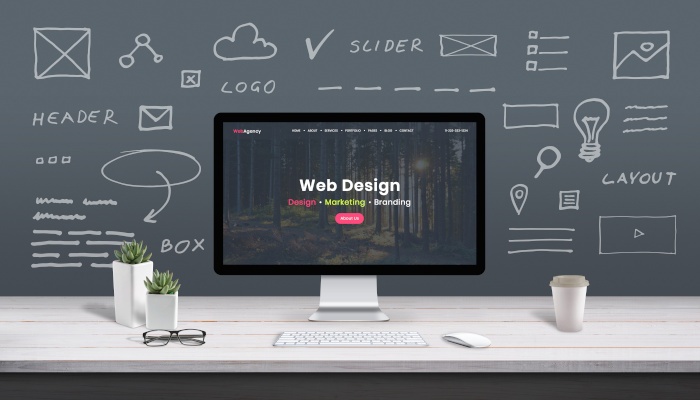User Experience (UX) Design for Websites
Mark Wilson


Mark Wilson

Jeff Bezos is one of the world’s richest people. There are a lot of reasons for this, but one of the most basic reasons relates to user experience (UX) design on his website, amazon.com.
See, Amazon wasn’t the best at what they did for a long time. In fact, when they were a small-time internet bookseller, their logistics infrastructure and resources were dwarfed by many larger organizations.
And if you look at their website today, with product pages that are often sprawling and occasionally confusing to navigate, it’s fair to say they’re still behind some of their competitors in terms of website functionality.
But what Amazon did more quickly and better than others was make purchasing easier. With your account set up, you can literally buy most products on their site with a single click. It’s terrifyingly easy.
This experience, one that’s more convenient than other purchasing methods, is in part what allowed Amazon to dominate the world of eCommerce. And it’s an innovation that’s due to user experience design.
You might not be the next Amazon, but you can improve your bottom line through UX design. Here at Leadflask, we’re experts in improving websites to create tangible results.
What is User Experience (UX) Design?
User experience design (UX) is a process wherein you create a product or tool that creates a specific experience for the user. User experience design can be applied to a variety of fields, but today we’ll be looking at website design.
In website terms, this means setting goals, identifying core users of the site, and deciding what type of experience you’d like those users to get from your website.
Then you create a site that reflects those goals. But it isn’t as simple as simply sitting down and making the website from scratch.
At Leadflask, our process is designed to create websites that match design with your intent for your users, resulting in better outcomes, both for visitors to the site and your company.
What Good UX Does for a Website?
The Amazon story above is an extreme example, but it’s a clear example of what good UX can do for a site.
At Leadflask, we like to work with hard data, because this is what allows us to measure effectiveness. To that end, here are some of the ways good UX can meaningfully contribute to a website’s functionality:
- Increased time on page - This relates to how much users enjoy using your site and also relates to the (lack of) frustration over using your site.
- Lower bounce rate - A webpage’s bounce rate is the percentage of people who visit only a single page on your site before leaving it entirely. If they’re clicking through to additional pages, this means that they’re finding topics of interest to explore on your website.
- Higher form fill rate - If forms are clear and easy to use, you’ll get more people filling them out. This could relate to eBook downloads, newsletter subscriptions, contact requests or purchases. The user experience within the form matters as well, because someone who begins to sign up for something but stops midway through is likely a user who encountered a frustration they weren’t expecting.
- More leads/sales - This is what it comes down to for many businesses. If you create an intuitive, simple-to-use user flow on a website, more visitors to your site will eventually become customers.
That list isn’t comprehensive, but can start to give you a sense of what to measure and what to expect from a refined UX process that is integrated into your website’s design philosophy.
Leadflask’s UX Design Process
That brings us to your journey as you seek to create or improve your brand’s website. And that’s where Leadflask comes in.
The user experience design process is one we like to apply to all significant projects, not just full designs of websites, because we find that we can achieve better results when we form a consistent plan to create a great end product.
Identify Users, Metrics and Site Goals
While this step isn’t technically part of the UX process, a great UX process can’t happen until you know who your audience is and what specific goals you want to achieve with a design.
Before the UX process begins, Leadflask will work collaboratively with you to identify data sources we’ll use to track results, and also to identify your core audiences so that we understand exactly what you want to achieve with your website’s design.
Without these steps, anything listed below will be less effective.
Wireframing
This is sometimes called “low fidelity” design. We’ve all seen sketch outlines of an object, and wireframing is a little bit like that.
The purpose is to roughly sketch out pages and elements of your site’s design.
Why do this instead of simply creating a live website right away? Because the first iteration will rarely be the best one, and changing a live website design takes a lot more time than changing a sketched outline.
Wireframing allows us to quickly experiment with a lot of design ideas, but without a ton of time or effort. It also allows you to review these designs and give feedback that we can quickly apply.
Higher Fidelity Designs
This is where we take the approved wireframes and start to turn them into designs that look like a completed website.
It’s important to note, at this stage we’re still only working on static images and design elements. It’s not yet a live website. The reason for this is again related to streamlining our process. Changing a static image is a lot quicker than changing a live website.
So you’ll get to see exactly what your site will look like, but with the benefit of still being able to quickly make changes.
Web Development
This is the actual creation of the website, the nitty-gritty coding that happens to bring it to life.
Like creating user personas, this starts to fall outside the UX process, but it’s important to know what comes before and after good UX planning.
Changes can still be made at this stage, and we’ll still be running tests for user experience, but a lot of this stage is simply coding out the elements that were approved in earlier steps.
User Testing
As much as you might obsess over your website (and just as we obsess over sites we create), sometimes being really close to a project makes you blind to its faults.
User testing refers to the process of having outside users interact with your website, with the specific purpose of providing feedback on their experience. Was anything confusing? Frustrating? What questions or suggestions do they have as a result of using the site?
This will produce insights that you could never come up with on your own, and even ones that we here at Leadflask couldn’t think of.
This is why it’s part of our testing process, to ensure that the website makes sense to typical users.
Analysis & Improvement
Relating back to our core company philosophy of continually improving in our work, we never want to complete a project and merely assume it’s going to work great.
RELATED: Redesigning Your Website: Working With Leadflask
The best results often come after a site has been launched, once we gather relevant user data and make adjustments to refine the design even further.
What sort of data is that? Many that we listed above, such as bounce rate and leads, can be excellent metrics to gauge the effectiveness of a design.
All of the testing before launch is great, but it should be paired with data collected once the site is live as well.
Differences Between UX and UI
UX is sometimes confused with UI, which stands for User Interface Design.
The two are related, and should be done side by side in a design process. But UX focuses more on the overarching experience a user has on a website, while UI focuses more on the aesthetics of the site and the visual interface of individual pages and page elements.
Bad UI can create bad UX, but the two use slightly different skills and best practices.
Website Ease of Use and Your Bottom Line
Let’s use a concrete example: If your company does roughly $10 million in revenue each year, and 80% of your leads come through your website, just a 5% increase in the conversion rate of web visitors will equate to roughly $400,000 in additional revenue per year.
Think back to our Amazon example. For many businesses, a 5% increase in revenue is the least you can expect, and even that can translate into millions of dollars over the course of several years.
This is the silent power good UX has. Your website is working for you 24/7 and for many modern companies is the primary or sometimes only source of leads for a business. It pays to make sure you’re getting the most out of it.
This can only happen with clear goals and a comprehensive plan to outline an experience path on a website, and then executing on that vision.
If you’re interested in learning more, and working directly with Leadflask to improve your site’s experience for its users, contact us today!
Additional Resources

Mark Wilson




